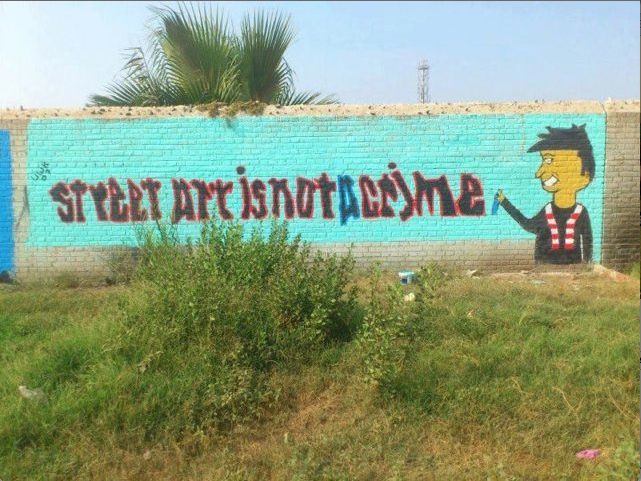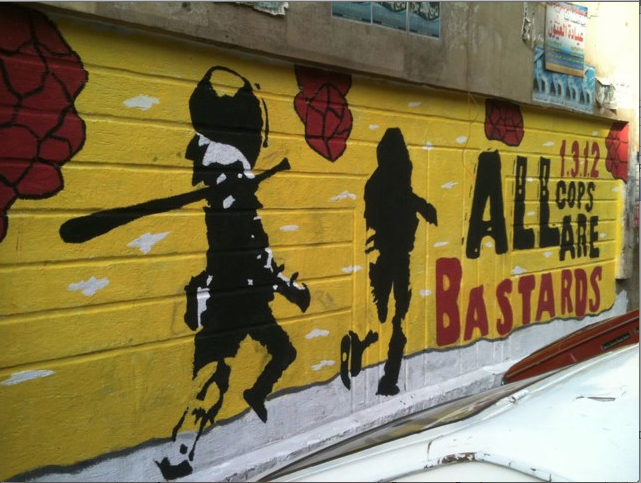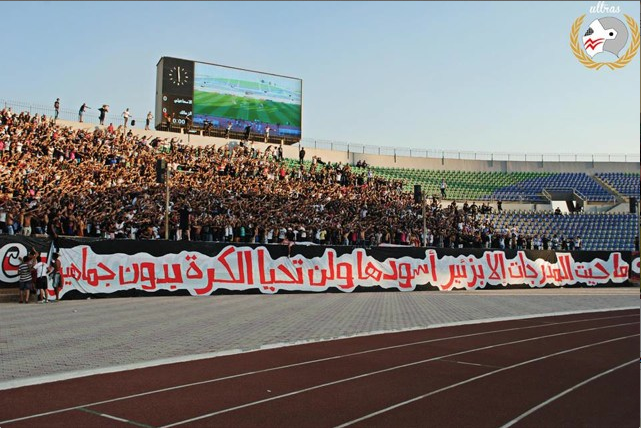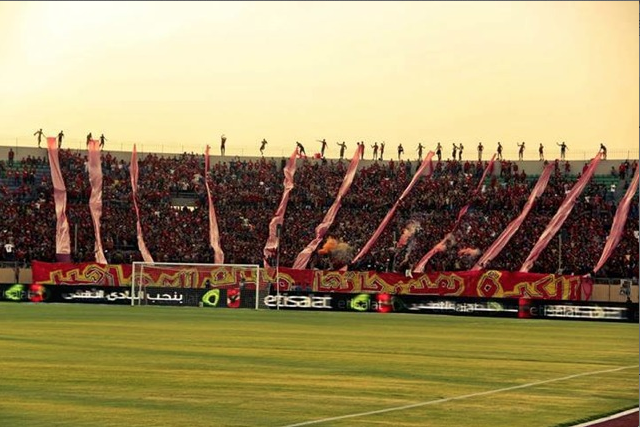Swinging between politics and football, the Egyptian “Ultras” football fans have spent the two years since the beginning of the 25 January Revolution trying to discover, redefine, and highlight their collective identity as youths who came together to express their love for sport in general, and for their chosen football clubs in particular. Before the revolution, the presence of these groups in the public sphere was limited, and tied to their contentious relationship with the state security forces, who tried to control their activities in Egypt’s stadiums. Suddenly, four years after their founding, everyone was talking about the courageous participation of the Ultras in the revolution, and of the crucial role they had played in defeating the police on 28 January 2011.
The Ultras’ collective political involvement started during the November 2011 clashes in Mohamed Mahmoud Street in Cairo, when the groups’ members perceived the killing of Mohamed Mostafa Karika, an Ultras Ahlawy (UA) member, and the detention of Shika Omran, an Ultras White Knights (UWK) member, as a threat to the Ultras as groups and not as ordinary Egyptians.[1] This collective engagement increased when they mobilized to demand justice for victims of the Port Said massacre, in which over seventy young Ultras supporting Cairo’s al-Ahly team were attacked and killed by other spectators, apparently under police watch. Given this mobilization, many observers imagined that the Ultras were becoming a political force, despite the fact that they themselves have never made such a claim.
Today, as public anger increases against the Muslim Brotherhood and their representative in the presidency, Mohamed Morsi, the Ultras groups seem to be uninterested in engaging with heated political conflict, although they do have their reasons to be angry. Their current source of anger is the authorities’ ban on their attendance of the Egyptian league championship and the African League cup matches. Most of Egypt’s Ultras groups issued statements challenging this ban and asking the Minister of State for Sports Affairs, Al-‘Amry Farouk, to lift it or accept that the Ultras would attend the matches whatever the consequences.
This article argues that the Egyptian Ultras groups, as collective bodies, will no longer become involved in Egypt’s ongoing political conflicts, as the past two years of political engagement has led to profound and undesired changes to the original nature and goals of the Ultras as a movement. This argument unfolds by responding to two main questions: first, is there a clear relationship between the Ultras groups and Egyptian politics? This entails a discussion of the relationship between the Ultras groups, which were founded in 2007, and the Egyptian state on one hand, and the interactions between the Ultras and the revolutionary process on the other. The second question asks why the Ultras groups withdrew from the political scene, and chose to focus on their struggle to go back to the stadiums? Here, the relationship between the Ultras and the stadium, and specifically the curva,[2] needs to be highlighted, as a symbol and a reflection of their collective identity, and finally the role of the leadership in preserving the groups’ internal cohesiveness, based on the authority and credibility they have earned with the ordinary members within each group.
The Contentious Relationship between Ultras and State
In Egypt, there were earlier generations of associations designed to provide support for sports teams: these were called Fan Associations (FA). For the most part, the board members of the football clubs established the FAs, provided the funding for their activities, and often received highly discounted or free tickets to matches in return. It was not uncommon for board members or even players to attempt to influence the FAs to achieve personal goals such as swaying the vote in club elections, or placing pressure on those with whom they had disputes. Meanwhile, the relationship between the FAs and the police was very smooth. In the words of “Buffon”*, a member of the Zamalek-affiliated Ultras White Knights: “We were well known to the police officers and we used to greet each other.”[3] This problem-free relationship between the police and the FAs is understandable, since the latter did not pose any threat to the regime of ousted president Hosni Mubarak, the police, or to the maintenance of order inside and outside the stadium. So what then happened to transform the relationship between Egyptian fans and police into such a contentious one?
In 2007, the younger members of the FAs sought to eliminate the influence of the clubs’ board members. As they traveled abroad to attend their teams’ matches, they became exposed to the ideas of older Ultras groups, especially those based in North Africa. Visiting Tunisia, where the first Ultras groups were established in the Arab world, Egyptian youths were exposed to the new styles of football supporting adopted by fans of such famous sports clubs as al-Taragy. In 2007, they took the decision to found a new form of association, the Ultras groups, which soon adopted novel forms of football supporting, and developed a strong collective identity.[4] Their strict organization in the stadium, along with the autonomy they claimed from the domination of club board members and FAs over their supporting tactics, concerned the authorities. The latter attempted to understand the characteristics of these new groups, and what their existence in society meant for state authority.
In the first years of the groups’ existence, security forces viewed them as a threat to public order and to order within the stadium, as they used fireworks, and sometimes insults, against rival groups and teams. In 2008, during a match between al-Ahly and the Police Union teams, the security forces charged with securing the stadium prevented the Ultras from taking any of their props inside. In retaliation, the group clashed violently with the police.

[Graffiti in Cairo says “Respect Existence or Expect Resistance” as part of the Ultras’ campaign for their freedom in the curva. Photo by Mohamed al-Gohary, March 2013, Cairo]
These levels of contention between the Ultras and the police stemmed from a few key issues: first, the limits placed upon the Ultras’ freedom within the stadium created significant resentment toward the state. Fans were not allowed to use pyrotechnics in the stadiums. The Ultras proceeded to break this rule, which generated clashes between their members and the security forces, and generally resulted in the arrest of Ultras members. According to their own statements, the Ultras sought to express themselves freely within the stadium, in support of their team, without any intervention from security officials or restrictions from the Egyptian Football Associations (EFA). They further asserted that the rules governing the curva must be set by the fans themselves, not by repressive police officers or corrupt EFA officials. Connected to the dispute over freedom in the stadium, there has long been tension between the Ultras and the police or EFA over the right to attend the matches. The security forces and EFA always have the final say on whether fans are allowed to attend matches.

[A message from members of the Ultras Ahlawy (UA), supports of al-Ahly club, in the stadium, reads “Don’t tell me how to support”. Photo from the Ultras Ahlawy facebook page]
A second point of contention between the Ultras and the police, which appeared clearly after the 25 January Revolution, revolved around the freedom to draw graffiti. The Ultras depended on graffiti to communicate their ideas, beliefs, and causes, but the police would harass and sometimes arrest the Ultras graffiti artists, as they were considered to be defacing public walls, a crime in Egypt. In Port Said in August 2012, three members of the Ultras Green Eagles (UGE), supporters of Port Said football club, were detained for painting graffiti against the government.

[Graffiti by members of the Ultras White Knights (UWK), supporters of al-Zamalek club. Photo from UWK facebook page]
Perhaps the most important point of contention for the Ultras was the authorities’ prohibition of politics in the stadium. The Egyptian Ultras groups, as collective bodies, do not hold a specific political ideology. However, as individuals, Ultras members hold very diverse political stand points. Before high-profile or important matches, security officials would usually meet with Ultras representatives, and one of their principal demands was that members refrain from displaying any politically meaningful signs, and that all members of oppositional groups such as the 6 April Youth Movement be excluded. In May 2010, in accordance with this prohibition of politics, the security forces forced the Ultras White Knights to cancel one of their “tifos”, or choreographed message formations, which had been dedicated to the support of the Palestinian cause in one of their team’s matches
Along with these constraints, state security officials initially tried to infiltrate the Ultras groups and use their members to achieve some of the regime’s goals, especially during the election campaigns. For example, former Minister of Interior Habib al-Adly tried hard to co-opt them, but his attempts failed.[5] Consequently, the regime and the police adopted a new offensive strategy aimed at containing or eliminating the Ultras instead. This happened after a match between al-Ahly and al-Ismaili in the 2009-2010 local league season, when massive clashes erupted between the rival supporters, Ultras Ahlawy and Ultras Yellow Dragons (UYD). After this match, about a hundred UA members were arrested. The state security apparatus then created a special office to handle matters relating to the Ultras groups’ presence in the public sphere.[6]
The police worked hard to control and interfere with the affairs of the Ultras, particularly by sanctioning their visual and oral forms of expression. For the Ultras to be permitted to attend matches by the security forces, they were obliged to give detailed accounts of the activities that they had planned for the upcoming match. The Ultras railed against such interference, which led to changes such as the UA canceling the tifo that they had been planning for a derby match against al-Zamalek in November 2010.
The names of the most influential members within the Ultras groups were known to the security officers,[7] which would result in security forces detaining particular group leaders the night before each game. The derby matches between al-Ahly and al-Zamalek were an occasion for the security forces to demonstrate their control over the Ultras groups and their ability to deter and halt any undesirable behavior by them. In preparation for a derby match in April 2010, police officials planned strict security procedures: thirty police checkpoints, policewomen who would thoroughly check female fans, and hidden surveillance cameras. In addition, security forces prevented fans from bringing water bottles, food, large flags, and fireworks into the stadium. The police also refused to let certain members of UA and UWK into the stadium. Later that year, in December 2010, and immediately preceding the second derby match, the security forces detained fifty Ultras personnel as a precaution against the possibility of any violence between the two rival Ultras groups.
Due to these continuous crackdowns by police, Ultras members began to view the police as enemies, not only in Egypt, but also throughout the world. From the Ultras members’ perspective, the regime employed the police as a force whose ultimate goal was to control society and enslave individuals. In each country in which Ultras exist, repressive procedures have been executed by the state through the police, leading to the adoption of the popular Ultras slogan “All Cops Are Bastards” (ACAB). Utilized by Ultras throughout the world, this slogan demonstrates the prevalence of their anti-police stance, which also appears in songs, chants, and graffiti practices. The Ultras are rebellious by nature, and refuse any forms of control, injustice, and oppression, resisting all restrictions by security forces.[8]

[Graffiti by members of the Ultras Ahlawy (UA), supporters of al-Ahly club. Photo from UA facebook page]
To confront the coercion of the state security forces, Ultras members adopted a variety of methods of resistance. They began to employ vengeful violence against the police: this was the initial step in breaking the conventional view that the monopoly on tools of coercion belonged with the state. The clash that occurred between UA and the security forces in Port Said in 2008 was a turning point in the course of the relationship between the Ultras and the police. Violence against the police was not familiar to many ordinary Egyptians, who knew from bitter experience that the brutality of the police could not easily be resisted. However, according to one of the UA members who was present at the event, “this particular battle with the police was crucial in changing people’s beliefs regarding the absolute strength of the police.”
The relationship between security officials and Ultras group leaders has not been consistently contentious, however. There has been some necessary coordination between security officials and the Capos[9] of the Ultras groups, mostly before particularly sensitive matches. Before the revolution, such meetings were held before the derby matches between al-Ahly and al-Zamalek.[10] This coordination began after security officials realized that a violent approach to Ultras’ affairs could not be successful, and that the Ultras could cause trouble if they felt humiliated. For their part, the Ultras recognized that they would not be able to defeat the state completely, since the police was in its service, and had a huge arsenal of arms.[11] This mutual understanding of the other’s strength led to occasional cooperation between the two sides.
The Dialectical Relationship with the Revolution: The Ultras Face New Realities
The 25 January Revolution created new contexts, in which all social actors, not only the Ultras, found themselves amidst an extended political and social conflict between state and society. In interacting with these realities, the Ultras groups confronted more challenges than many other social and political groups did.
When a revolutionary or reformist political group engages in political activism against the incumbent regime, that group may seize the opportunity which a revolution affords to participate in overturning the regime and then attempt to change the rules of the political game. By contrast, a conservative political group may well decide to align with the incumbent regime itself against the revolution and the revolutionaries. For an apolitical group as internally diverse as the Ultras, however, deciding on this issue is not as easy.
The dilemma for the Ultras groups regarding participation in the revolution emanated from two of their main features: first, their intrinsically apolitical nature, and second, the internal diversity of their various groups’ experiences, especially with regard to the political preferences of individual members. The core idea that brings the Ultras groups’ internal organization together is not ideological or political background, but rather love and loyalty to the club. Based on this, the groups’ leaders can ensure discipline within the groups.
There are many bases for the Ultras members’ obedience to the seniors. First, an ordinary member can only become a leader after a very extensive process of experience accumulation related to the functioning of the group. During that time, members face many difficult situations, and they must display the skills to deal with them. Based on these experiences, the person enjoys credibility and authority among the ordinary members.[12] Second, ordinary members perceive that observance of the leaders’ instructions serves the ultimate and fundamental interests of the club and their groups in the face of rival groups inside and outside the stadium. The last motive that leads to obedience is the fear of being excluded from the group if they disregard instructions, shirk the task assigned, or violate any of the Ultras’ general rules and laws.[13] Those who do not comply with leaders’ instructions, and make decisions on their own, are not welcome in the group and must leave, even if they are influential figures. Mohamed Gamal Bishir, also known as Gemey Hood, a blogger who was one of the founding members of UWK, violated two main Ultras laws: avoidance of media exposure, and respect for the secrecy of group affairs. He appeared in the media to speak about the Ultras, and wrote a book about them, which has been published and read by thousands in Egypt.[14]
One of the main tasks which leaders assign their members is a certain activity inside the curva. The task, or “al-mission” as the Ultras members like to call it, plays a very important organizational role, bringing together all group members inside the stadium. The mission fosters the cohesiveness of the group, and whenever it is absent, this cohesiveness is threatened, and the potential for internal division grows. Indeed, any movement is liable to collapse if its collective action, behavior, and discourse cease to express the core components of its collective identity.[15] For the Ultras, the absence of the unifying repertoires of the curva lasted for two years, especially after the Port Said disaster, and then the suspension of the local league.
Being unable to enforce much discipline outside the scope of particular “missions”, leaders were unable to impose any political decisions on group members once the 25 January protests began. As a result, for several months, many Ultras’ interaction with the revolution was performed on the level of the individual. Ultras Ahlawy and Ultras White Knights released statements before the 25 January protests stressing that the two groups had been founded in the spirit of supporting football, and that they had nothing to do with politics. At the same time, the statements also confirmed the freedom of each individual to participate in the protests according to their personal political preferences.
One of the main reasons why so many Ultras members decided to participate in the protests was the violent history between Ultras groups and security forces. The idea of targeting the police on its national anniversary, 25 January, unified the rival Ultras groups in their motivation to confront the security apparatus. Mohamed Ahmed, a UA member, recalls heading to the protests with a friend from UWK: “when we saw the violent police reaction, we remembered the way the police used to treat us on our way into the stadium or even in the streets.” How did this participation in the revolution affect the Ultras groups’ internal dynamics?
The engagement of the Ultras members with other revolutionaries and political forces during and after the revolution profoundly altered the groups’ public discourse, the way in which they deal with society and with the state and police. As mentioned earlier, there had previously been no room for politics inside the groups. However, the revolution, with the prominent involvement of many individual Ultras members, and subsequently the killing of seventy-two UA members in Port Said on February 2012, exposed the groups to the function and nature of political work and political activism. Instead of depending on vengeful violence against the police and state, they learned how to employ a variety of political pressure strategies, to bring retributive justice. For the first time, Egyptians witnessed the Ultras organizing political marches, protests, sit-ins, and using politically motivated violence against the state institutions. It can thus be said that the revolution helped the Ultras normalize the use of strategies of political pressure rather than merely vengeful violence.
The revolution also altered the Ultras groups’ internal dynamics, leaving its mark on the cohesiveness of their organization as well as on the “Ultras mentality”, entailed in being a part of the brotherhood. The unity and solidarity that originated in a common passion for the club, and the strong personal bond that had been created between the members, began to weaken and dissolve. Politics, by definition, implies compromises, variations in opinion and behavior, and perhaps fundamental divisions. Spending more than a year away from the curva’s unifying “missions”, and engaging in politics instead, weakened these groups’ internal ties. Ultras groups, especially UA, witnessed divisions over the future roles of the groups after the final verdicts concerning the Port Said case, which were delivered on 9 March 2013. On 16 June, Ultras Devils (UD), the other large Ultras group that supports the al-Ahly Club, suspended its activities until further notice. The suspension, as its appears from the members’ comments on the group’s facebook page, came on the grounds of internal divisions concerning the most appropriate way to bring those who planned the Port Said crime to justice. Some wished to escalate against the regime until full retribution was achieved for their murdered friends, while others feared more bloodshed, and wished to return to the stadium and creatively support their team there.
Amidst these tensions, Ultras leaders seem to have concluded that continuing with political engagement risked eroding the collective identity of the groups, which might lead to their collapse.[16] It is this attitude, I believe, that provides the context for the Ultras groups’ recent persistence in challenging the ban on allowing fans to attend league matches and disregarding the calls for massive protests against the Egyptian president Mohamed Morsi on 30 June.

[A message from UWK in the stadium reads “The terraces only survive on their lions’ roars, and football cannot survive without its fans”. Photo from UWK facebook page]

[A message from members of the Ultras Ahlawy (UA), supporters of al-Ahly club, in the stadium, reads “Football and the terraces are fans’ property”. Photo from UA facebook page]
A collective political role for the Ultras groups in the future is unlikely to be repeated unless there appears another immediate threat to their identity akin to the events of Port Said. The Ultras groups’ identity simply cannot survive outside the stadium and the curva. This is why UA, UWK, UGE, and the Ultras Yellow Dragons of Ismailiyya have all insisted on attending their teams’ matches against the authorities’ will. While individuals may still head to the protests on 30 June, as groups, the Ultras have clearly decided, with great passion and persistence, to leave politics behind and go back to their home, the curva.
References
[1] Ultras Ahlawy support al-Ahly Club, while Ultras White support al-Zamalek Club.
[2] The term “Curva” is an Italian expression referring to a specific place in the stadium chosen by the Ultras as its location during their teams’ matches.
* I identify informants using initials or nicknames, to preserve their anonymity.
[3] UWK member nicknamed “Buffon”, Interview by the author, 11March 2013.
[4] UWK A.S, Interview by the author, 9 March 2013
[5] Dina Yossif, Interview by the author, 4 March 2013.
[6] Hany Darwish, Interview by the author, 10 March 2013.
[7] M.G, UA, and UA M.A. Interview by the author, 15 March 2013.
[8] UWK A.S., Interview by the author, 9 March 2013.
[9] The Capo, an Italian word loosely translated as “leader”, is the person in charge of the curva. He leads the chants and other activities in the stadium. Capos are the only leaders known to the rest of the groups. There are other Ultras members who are in charge of the group’s affairs, but they are not known to the rest of the group. A Capo is chosen based on some personal characteristic such as charisma, and possession of a strong voice, as he has to lead sustained chanting. During football matches, the tiniest sign by the Capo’s hand can lead to an explosion of chants, or transform the terrace into a work of art.
[10] Buffon, Interview by the author.
[11] Buffon, Interview by the author.
[12] A.S, Interview by the author.
[13] Buffon, Interview by the author.
[14] Buffon, Interview by the author.
[15] Francesca Polletta and James M. Jasper, “Collective Identity and Social Movements,” Annual Review of Sociology 27 (2001), 292.
[16] Polletta and Jasper, “Collective Identity and Social Movements,” 292.